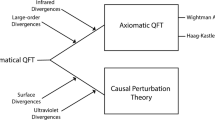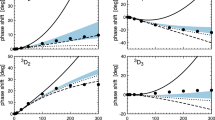Abstract
In comparison with theWT chiral identity which is indispensable for renormalization theory, relations deduced from the non-linear chiral transformation have a totally different physical significance. We wish to show that non-linear chiral transformations are powerful tools to deduce useful integral equations for propagators. In contrast to the case of linear chiral transformations, identities derived from non-linear ones contain more involved radiative effects and are rich in physical content. To demonstrate this fact we apply the simplest non-linear chiral transformation to the Nambu-Jona-Lasinio model, and show how our identity is related to the Dyson-Schwinger equation and Bethe-Salpeter amplitudes of the Higgs and π. Unlike equations obtained from the effective potential, our resultant equation is exact and can be used for events beyond the LEP energy.
Similar content being viewed by others
References
Y. Nambu, G. Jona-Lasinio: Phys. Rev. 122 (1961) 345
Y. Nambu: “BCS Mechanism, Quasi-Supersymmetry, and Fermion Mass Matrix”*, talk presented at the Kasimierz Conference, EFI 88-39 (July 1988), see also International Workshop reports of 1988 and 1989, Nagoya, Japan: Ed. Bando, Muta and Yamawaki, Also there are a number of pioneer works on the top condensate by Nagoya group, K. Yamawaki in particular, around 1989–1990. The most of early ones are published in the Modern Physics Letters, the Modern Physics and reports of international workshops held at Nagoya from 1988 to 1990: (Ed. Yamawaki et al, World Scientific)
J. Schwinger: Proc. Nat. Acad. Sci. 37 (1951) 452
As clear illustrations from the perturbative viewpoint, one may consult K. Nishijima: Fields and Particles, New York: Benjamin, Inc. 1969, T. Muta: Foundation of Quantum chromodynamics, Singapore, World Scientific, 1987. For the non-perturbative aspect, we cite the latest book by J. Zinn-Justin: Quantum Field Theory and Critical Phenomena, New York, Oxford University Press 1990
For the derivation of DS and BS equations, see for example chapter 10 of C. Itzykson and J.B. Zuber: Quantum Field Theory, Singapore, McGraw Hill, 1986
K. Fujikawa: Phys. Rev. D21 (1980) 2848
H. Fukuda, Y. Miyamoto: Proc. Theor. Phys. 4 (1949) 235, 347; S. Adler: Phys. Rev. 177 (1969) 2426
There exist a number of articles by Fujikawa. As a summary talk for early works see p. 106 of Quantum Gravity and Cosmology: ed. H. Sato and T. Inami, Singapore, World Scientific, 1986
J.L. Jacquot: Phys. Lett. B212 (1988) 231; J.L. Jacquot and M. Umezawa: Z. Phys. C45 (1990) 381
J.L. Jacquot, J. Richert: Z. Phys. C56 (1992) 201
T. Eguchi, H. Sugawara: Phys. Rev. D10 (1974) 4257
K. Kikkawa: Prog. Theor. Phys. 56 (1976) 947
T. Eguchi: Phys. Rev. D14 (1976) 2755
W.A. Barden, C.T. Hill, M. Lintner: Phys. Rev. D41 (1990) 1647.
C.T. Hill: Top Quark Condensates, unpublished, Fermi-Pub-92/19-T, Jan, 15. 1992
The point of view on the symmetry breaking resulting from this transformation has been presented by us p. 359 of the Bregenz Symposium “Symmetry in Science VI” 1992, ed. B. Gruber. Plenum Press, New York 1993. Here only the mass generation of quarks is treated in the ladder approximation. All terms which do not contribute to the quark mass are ignored. The Bethe-Salpeter amplitudes for bound states φ and π (ourD ϕ andD π) are neglected too
J. Schwinger: Phys. Rev. 82 (1951) 664
M. Umezawa: Phys. Rev. D39 (1989) 3672
M. Suzuki: Mod. Phys. Lett. A5 (1990) 1205; see also W.A. Bardeen “Electroweak Symmetry breaking: Top Quark Condensates”, the 5th Nishinomiya Yukawa Memorial Symposium. Oct. 25 (1990)
A. Hasenfratz, P. Hasenfratz. K. Jansen, J. Kuti, Y. Shen: “The Equivalence of the Top Quark Condensate and the Elementary Higgs Field”, USCD/PTH 91-06 (1991)
As one of the later examples, we cite theZ→2γ decay. See T. Hatzuda, M. Umezawa: Phys. Lett. B254 (1991) 493; All other references are cited therein. T. Hatzuda, M. Umezawa: The DecayZ→σγ, CRN Report (unpublished 1990). TheZ→σμ+μ− as a test of the usage of PCDC in high energy phenomena. CRN Report (unpublished 1991): The Decay ofZ to a Dialton and a μ pair: PCDC and the Decay Form Factor. CRN Report (unpublished 1992)
K. Kondo, M. Tanabashi, K. Yamawaki: “Renormalization in the Gauged Nambu-Jona-Lasinio Model”, unpublished, KEK-TH-344, DPNU-92-23. Other useful references are cited therein.
Author information
Authors and Affiliations
Rights and permissions
About this article
Cite this article
Jacquot, J.L., Richert, J. & Umezawa, M. Equations from non-linear chiral transformations. Z. Phys. C - Particles and Fields 66, 309–314 (1995). https://doi.org/10.1007/BF01496605
Received:
Revised:
Issue Date:
DOI: https://doi.org/10.1007/BF01496605




